Jialong Zuo
Sparse Alignment Enhanced Latent Diffusion Transformer for Zero-Shot Speech Synthesis
Feb 26, 2025Abstract:While recent zero-shot text-to-speech (TTS) models have significantly improved speech quality and expressiveness, mainstream systems still suffer from issues related to speech-text alignment modeling: 1) models without explicit speech-text alignment modeling exhibit less robustness, especially for hard sentences in practical applications; 2) predefined alignment-based models suffer from naturalness constraints of forced alignments. This paper introduces \textit{S-DiT}, a TTS system featuring an innovative sparse alignment algorithm that guides the latent diffusion transformer (DiT). Specifically, we provide sparse alignment boundaries to S-DiT to reduce the difficulty of alignment learning without limiting the search space, thereby achieving high naturalness. Moreover, we employ a multi-condition classifier-free guidance strategy for accent intensity adjustment and adopt the piecewise rectified flow technique to accelerate the generation process. Experiments demonstrate that S-DiT achieves state-of-the-art zero-shot TTS speech quality and supports highly flexible control over accent intensity. Notably, our system can generate high-quality one-minute speech with only 8 sampling steps. Audio samples are available at https://sditdemo.github.io/sditdemo/.
Enhancing Expressive Voice Conversion with Discrete Pitch-Conditioned Flow Matching Model
Feb 08, 2025



Abstract:This paper introduces PFlow-VC, a conditional flow matching voice conversion model that leverages fine-grained discrete pitch tokens and target speaker prompt information for expressive voice conversion (VC). Previous VC works primarily focus on speaker conversion, with further exploration needed in enhancing expressiveness (such as prosody and emotion) for timbre conversion. Unlike previous methods, we adopt a simple and efficient approach to enhance the style expressiveness of voice conversion models. Specifically, we pretrain a self-supervised pitch VQVAE model to discretize speaker-irrelevant pitch information and leverage a masked pitch-conditioned flow matching model for Mel-spectrogram synthesis, which provides in-context pitch modeling capabilities for the speaker conversion model, effectively improving the voice style transfer capacity. Additionally, we improve timbre similarity by combining global timbre embeddings with time-varying timbre tokens. Experiments on unseen LibriTTS test-clean and emotional speech dataset ESD show the superiority of the PFlow-VC model in both timbre conversion and style transfer. Audio samples are available on the demo page https://speechai-demo.github.io/PFlow-VC/.
Speech Watermarking with Discrete Intermediate Representations
Dec 18, 2024Abstract:Speech watermarking techniques can proactively mitigate the potential harmful consequences of instant voice cloning techniques. These techniques involve the insertion of signals into speech that are imperceptible to humans but can be detected by algorithms. Previous approaches typically embed watermark messages into continuous space. However, intuitively, embedding watermark information into robust discrete latent space can significantly improve the robustness of watermarking systems. In this paper, we propose DiscreteWM, a novel speech watermarking framework that injects watermarks into the discrete intermediate representations of speech. Specifically, we map speech into discrete latent space with a vector-quantized autoencoder and inject watermarks by changing the modular arithmetic relation of discrete IDs. To ensure the imperceptibility of watermarks, we also propose a manipulator model to select the candidate tokens for watermark embedding. Experimental results demonstrate that our framework achieves state-of-the-art performance in robustness and imperceptibility, simultaneously. Moreover, our flexible frame-wise approach can serve as an efficient solution for both voice cloning detection and information hiding. Additionally, DiscreteWM can encode 1 to 150 bits of watermark information within a 1-second speech clip, indicating its encoding capacity. Audio samples are available at https://DiscreteWM.github.io/discrete_wm.
Holmes-VAU: Towards Long-term Video Anomaly Understanding at Any Granularity
Dec 09, 2024Abstract:How can we enable models to comprehend video anomalies occurring over varying temporal scales and contexts? Traditional Video Anomaly Understanding (VAU) methods focus on frame-level anomaly prediction, often missing the interpretability of complex and diverse real-world anomalies. Recent multimodal approaches leverage visual and textual data but lack hierarchical annotations that capture both short-term and long-term anomalies. To address this challenge, we introduce HIVAU-70k, a large-scale benchmark for hierarchical video anomaly understanding across any granularity. We develop a semi-automated annotation engine that efficiently scales high-quality annotations by combining manual video segmentation with recursive free-text annotation using large language models (LLMs). This results in over 70,000 multi-granular annotations organized at clip-level, event-level, and video-level segments. For efficient anomaly detection in long videos, we propose the Anomaly-focused Temporal Sampler (ATS). ATS integrates an anomaly scorer with a density-aware sampler to adaptively select frames based on anomaly scores, ensuring that the multimodal LLM concentrates on anomaly-rich regions, which significantly enhances both efficiency and accuracy. Extensive experiments demonstrate that our hierarchical instruction data markedly improves anomaly comprehension. The integrated ATS and visual-language model outperform traditional methods in processing long videos. Our benchmark and model are publicly available at https://github.com/pipixin321/HolmesVAU.
WavChat: A Survey of Spoken Dialogue Models
Nov 26, 2024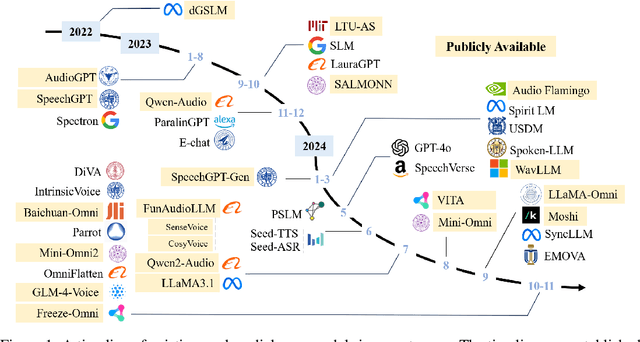

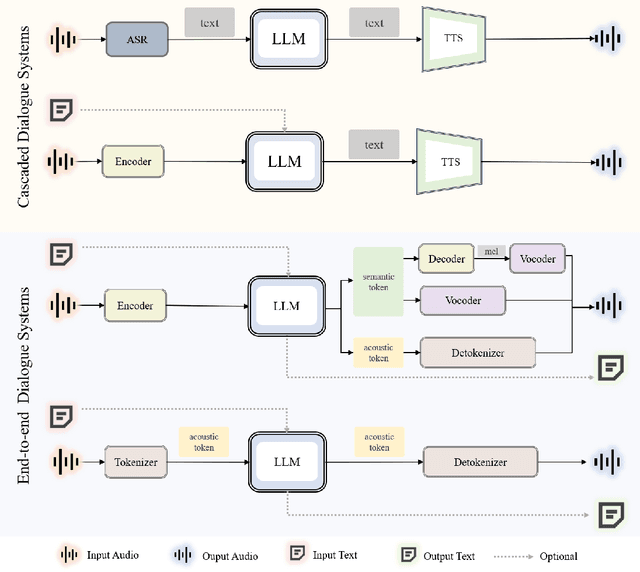
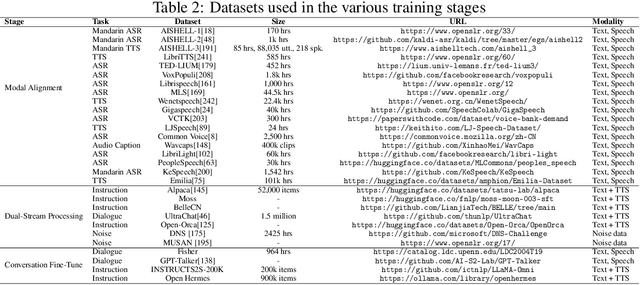
Abstract:Recent advancements in spoken dialogue models, exemplified by systems like GPT-4o, have captured significant attention in the speech domain. Compared to traditional three-tier cascaded spoken dialogue models that comprise speech recognition (ASR), large language models (LLMs), and text-to-speech (TTS), modern spoken dialogue models exhibit greater intelligence. These advanced spoken dialogue models not only comprehend audio, music, and other speech-related features, but also capture stylistic and timbral characteristics in speech. Moreover, they generate high-quality, multi-turn speech responses with low latency, enabling real-time interaction through simultaneous listening and speaking capability. Despite the progress in spoken dialogue systems, there is a lack of comprehensive surveys that systematically organize and analyze these systems and the underlying technologies. To address this, we have first compiled existing spoken dialogue systems in the chronological order and categorized them into the cascaded and end-to-end paradigms. We then provide an in-depth overview of the core technologies in spoken dialogue models, covering aspects such as speech representation, training paradigm, streaming, duplex, and interaction capabilities. Each section discusses the limitations of these technologies and outlines considerations for future research. Additionally, we present a thorough review of relevant datasets, evaluation metrics, and benchmarks from the perspectives of training and evaluating spoken dialogue systems. We hope this survey will contribute to advancing both academic research and industrial applications in the field of spoken dialogue systems. The related material is available at https://github.com/jishengpeng/WavChat.
OmniSep: Unified Omni-Modality Sound Separation with Query-Mixup
Oct 28, 2024



Abstract:The scaling up has brought tremendous success in the fields of vision and language in recent years. When it comes to audio, however, researchers encounter a major challenge in scaling up the training data, as most natural audio contains diverse interfering signals. To address this limitation, we introduce Omni-modal Sound Separation (OmniSep), a novel framework capable of isolating clean soundtracks based on omni-modal queries, encompassing both single-modal and multi-modal composed queries. Specifically, we introduce the Query-Mixup strategy, which blends query features from different modalities during training. This enables OmniSep to optimize multiple modalities concurrently, effectively bringing all modalities under a unified framework for sound separation. We further enhance this flexibility by allowing queries to influence sound separation positively or negatively, facilitating the retention or removal of specific sounds as desired. Finally, OmniSep employs a retrieval-augmented approach known as Query-Aug, which enables open-vocabulary sound separation. Experimental evaluations on MUSIC, VGGSOUND-CLEAN+, and MUSIC-CLEAN+ datasets demonstrate effectiveness of OmniSep, achieving state-of-the-art performance in text-, image-, and audio-queried sound separation tasks. For samples and further information, please visit the demo page at \url{https://omnisep.github.io/}.
Cross-video Identity Correlating for Person Re-identification Pre-training
Sep 27, 2024



Abstract:Recent researches have proven that pre-training on large-scale person images extracted from internet videos is an effective way in learning better representations for person re-identification. However, these researches are mostly confined to pre-training at the instance-level or single-video tracklet-level. They ignore the identity-invariance in images of the same person across different videos, which is a key focus in person re-identification. To address this issue, we propose a Cross-video Identity-cOrrelating pre-traiNing (CION) framework. Defining a noise concept that comprehensively considers both intra-identity consistency and inter-identity discrimination, CION seeks the identity correlation from cross-video images by modeling it as a progressive multi-level denoising problem. Furthermore, an identity-guided self-distillation loss is proposed to implement better large-scale pre-training by mining the identity-invariance within person images. We conduct extensive experiments to verify the superiority of our CION in terms of efficiency and performance. CION achieves significantly leading performance with even fewer training samples. For example, compared with the previous state-of-the-art~\cite{ISR}, CION with the same ResNet50-IBN achieves higher mAP of 93.3\% and 74.3\% on Market1501 and MSMT17, while only utilizing 8\% training samples. Finally, with CION demonstrating superior model-agnostic ability, we contribute a model zoo named ReIDZoo to meet diverse research and application needs in this field. It contains a series of CION pre-trained models with spanning structures and parameters, totaling 32 models with 10 different structures, including GhostNet, ConvNext, RepViT, FastViT and so on. The code and models will be made publicly available at https://github.com/Zplusdragon/CION_ReIDZoo.
WavTokenizer: an Efficient Acoustic Discrete Codec Tokenizer for Audio Language Modeling
Aug 29, 2024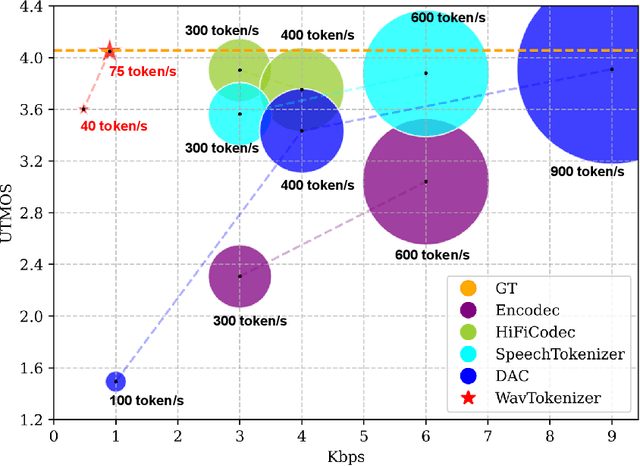
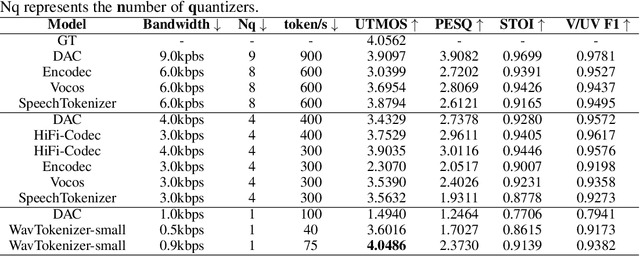

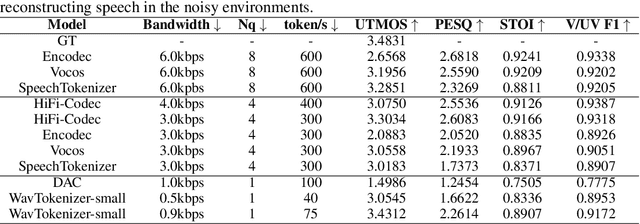
Abstract:Language models have been effectively applied to modeling natural signals, such as images, video, speech, and audio. A crucial component of these models is the codec tokenizer, which compresses high-dimensional natural signals into lower-dimensional discrete tokens. In this paper, we introduce WavTokenizer, which offers several advantages over previous SOTA acoustic codec models in the audio domain: 1)extreme compression. By compressing the layers of quantizers and the temporal dimension of the discrete codec, one-second audio of 24kHz sampling rate requires only a single quantizer with 40 or 75 tokens. 2)improved subjective quality. Despite the reduced number of tokens, WavTokenizer achieves state-of-the-art reconstruction quality with outstanding UTMOS scores and inherently contains richer semantic information. Specifically, we achieve these results by designing a broader VQ space, extended contextual windows, and improved attention networks, as well as introducing a powerful multi-scale discriminator and an inverse Fourier transform structure. We conducted extensive reconstruction experiments in the domains of speech, audio, and music. WavTokenizer exhibited strong performance across various objective and subjective metrics compared to state-of-the-art models. We also tested semantic information, VQ utilization, and adaptability to generative models. Comprehensive ablation studies confirm the necessity of each module in WavTokenizer. The related code, demos, and pre-trained models are available at https://github.com/jishengpeng/WavTokenizer.
MSceneSpeech: A Multi-Scene Speech Dataset For Expressive Speech Synthesis
Jul 19, 2024



Abstract:We introduce an open source high-quality Mandarin TTS dataset MSceneSpeech (Multiple Scene Speech Dataset), which is intended to provide resources for expressive speech synthesis. MSceneSpeech comprises numerous audio recordings and texts performed and recorded according to daily life scenarios. Each scenario includes multiple speakers and a diverse range of prosodic styles, making it suitable for speech synthesis that entails multi-speaker style and prosody modeling. We have established a robust baseline, through the prompting mechanism, that can effectively synthesize speech characterized by both user-specific timbre and scene-specific prosody with arbitrary text input. The open source MSceneSpeech Dataset and audio samples of our baseline are available at https://speechai-demo.github.io/MSceneSpeech/.
ACE: A Generative Cross-Modal Retrieval Framework with Coarse-To-Fine Semantic Modeling
Jun 25, 2024



Abstract:Generative retrieval, which has demonstrated effectiveness in text-to-text retrieval, utilizes a sequence-to-sequence model to directly generate candidate identifiers based on natural language queries. Without explicitly computing the similarity between queries and candidates, generative retrieval surpasses dual-tower models in both speed and accuracy on large-scale corpora, providing new insights for cross-modal retrieval. However, constructing identifiers for multimodal data remains an untapped problem, and the modality gap between natural language queries and multimodal candidates hinders retrieval performance due to the absence of additional encoders. To this end, we propose a pioneering generAtive Cross-modal rEtrieval framework (ACE), which is a comprehensive framework for end-to-end cross-modal retrieval based on coarse-to-fine semantic modeling. We propose combining K-Means and RQ-VAE to construct coarse and fine tokens, serving as identifiers for multimodal data. Correspondingly, we design the coarse-to-fine feature fusion strategy to efficiently align natural language queries and candidate identifiers. ACE is the first work to comprehensively demonstrate the feasibility of generative approach on text-to-image/audio/video retrieval, challenging the dominance of the embedding-based dual-tower architecture. Extensive experiments show that ACE achieves state-of-the-art performance in cross-modal retrieval and outperforms the strong baselines on Recall@1 by 15.27% on average.
 Add to Chrome
Add to Chrome Add to Firefox
Add to Firefox Add to Edge
Add to Edge